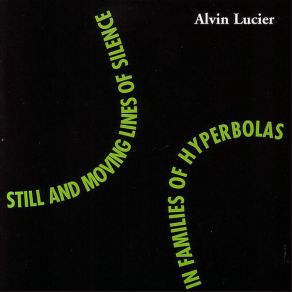Still and Moving Lines of Silence In Families of Hyperbolas
Download links and information about Still and Moving Lines of Silence In Families of Hyperbolas by Alvin Lucier, Conrad Harris, William Winant, Susan Palma, Dan Panner, Gregory Hesslink, James De Coursey, Rebecca Armstrong. This album was released in 2003 and it belongs to Electronica genres. It contains 12 tracks with total duration of 02:06:29 minutes.

|
|
|---|---|
| Artist: | Alvin Lucier, Conrad Harris, William Winant, Susan Palma, Dan Panner, Gregory Hesslink, James De Coursey, Rebecca Armstrong |
| Release date: | 2003 |
| Genre: | Electronica |
| Tracks: | 12 |
| Duration: | 02:06:29 |
| Buy it NOW at: | |
| Buy on iTunes $17.99 | |
| Buy on Amazon $17.98 | |
Tracks
[Edit]| No. | Title | Length |
|---|---|---|
| 1. | Clarinet (featuring Thomas Ridenour) | 11:56 |
| 2. | Marimba | 12:06 |
| 3. | Viola | 7:59 |
| 4. | Voice | 11:37 |
| 5. | Xylophone | 11:19 |
| 6. | Violin Duet | 8:34 |
| 7. | Flute | 10:03 |
| 8. | Glockenspiel | 12:35 |
| 9. | Cello (featuring Gregory Hesselink) | 7:55 |
| 10. | Horn (featuring James De Corsey) | 11:49 |
| 11. | Vibraphone | 12:28 |
| 12. | Violin Solo | 8:08 |
Details
[Edit]Four different versions exist of Alvin Lucier's 1972 work Still and Moving Lines of Silence in Families of Hyperbolas, of which this is the second (the others are gallery installations with or without percussion, and a live version with dancers). It consists of 12 separate pieces for instruments — 11 solos and one duet — playing with fixed oscillator tones. In most of the pieces the musicians sound 16 long notes, separated by silences, against one or two fixed oscillator tones, slightly raising and lowering their pitch to produce audible beats of varying speed. Four of the pieces, however, are scored for pitched percussion — marimba, xylophone, glockenspiel, and vibraphone — and since these instruments are unable to execute microtonal glissandi, Lucier instead calls for slow accelerandi and ritenuti. The interference patterns and aural byproducts produced — illusory glissandi, the apparent movement of sound around the listening space — are extraordinary. The reduced forces and utter simplicity of the concept make Still and Moving Lines an austere but spectacular listening experience. Not for headphones though: the sharp stereo separation of oscillator and instrument is designed to send the waves into the listening space, not the inner ear.